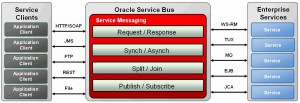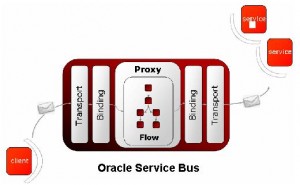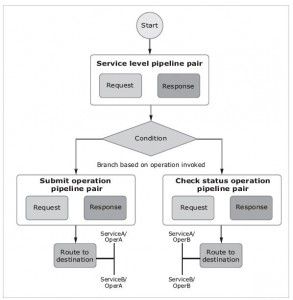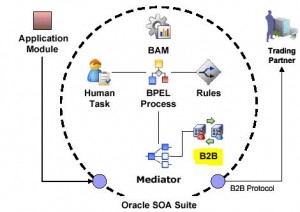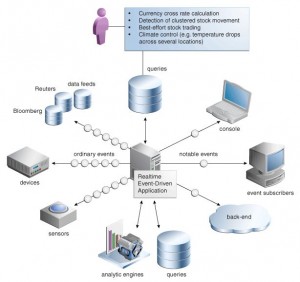Contents
This is part of 1Z0-451: Oracle SOA Foundation Practitioner Exam
<< Previous
Describe Oracle Service Bus Concepts and Architecture
Architecture Overview
* OSB, like other ESBs, provide message delivery service based on standards such as:
– SOAP
– HTTP
– JMS
* Message delivery features:
– High throughput
– Guaranteed delivery
* Payload:
– Native data type: XML
– Other data types: supports
* OSB is policy driven:
– Provide loose coupling between providers and consumers
– Maintaining centralized point of
~ security control
~ monitoring
* Metadata stores:
– Persistence policy
– Proxy service definitions
– Resource configurations
* Metadata can be customized and propagated (via import/export) from
dev -> staging -> prod
OSB as Intermediary
* Performs VETRO ESB pattern:
– Validate, Enrich, Transform, Route, Operate
* Switches transport protocols:
– Receive HTTP/S, File, FTP, JMS
– Outputs same or different protocols
* Message processing is specified in
– the message flow definition of a Proxy Service
Key Architecture Concepts
Message Processing
* Message can contain data and status about:
– application processes
– instructions for recipient
* Content based operations (via OSB transport and binding layers):
– routing
– transformation
Binding Layer
* Packs/unpacks messages as necessary
* Handles msg security
* Hands msg off to start (request or response) msg flows
Inbound/Outbound Transport Layer
* Responsible for input/output messages
* Not involved in data processing
Proxy Services
* Proxy services are OSB intermediary web services implementation
* Can be virtual services or composite services
* Exposed to service consumers
Message Context
* A set of XML variables shared across the request/response flow
* Can be
– read/modified by XQuery
– updated by transformation
* Wrapper variables:
– $header
– $body
– $attachments
* Wraps non-SOAP messages and exposes them as SOAP messages
Message Flow Definitions
* A message flow definition specifies implementation of a proxy service:
– Start node
– A pipeline pair: one for request and one for response
– Branch node: message content based
– Route node: message destination. Defaults to echo.
* Also includes security processing (WS-Sec, WS-Policy)
OSB Deployment
* Single server deployment
* Cluster of servers
Change Management
* Supported via configuration export/import
Metadata Export
* Export exiting OSB configurations, including all dependencies, into a JAR file.
* Only configurations that have been activated, i.e. deployed to run time, can be exported.
Metadata Import
* Imports configurations into an active session.
* Supports global replacements of environment specific elements
* Can be automated by WLST
References
* Oracle® Fusion Middleware Concepts and Architecture for Oracle Service Bus 11g Release 1 (11.1.1.4.0)
* Oracle ESB: Intro
* SOA 11g Tutorial: Virtualize Services with OSB
* Extending an Oracle 11g SOA Domain to Support OSB on SPARC 64
Describe Oracle Business Activity Monitoring
Overview
* BAM provides a framework for
– Creating dashboard that display real-time data inflow
– Creating rules to send alerts under specific conditions
– Designing web apps with graphs displaying active data
BAM Features
* Active data architecture
* Real-time reports
* Active presentations in reports
* Instant alerts
* Rules-based active delivery
* High performance, scalable architecture
BAM Components
* Real time data streaming: feeds data into BAM
– BAM Adapter: send data from composite to BAM server as 1) reference binding component 2) partner link in BPEL 3) sensor
– Direct JMS, aka JMS Connector or Enterprise Message Sources (EMS): BAM server can read data directly from any JMS based message q or topic
– Oracle Data Integrator: use ETL to feed data to BAM server
– Web services API: used by custom applications to feed data to BAM server
* BAM server
– Active Data Cache
– Event Engine: monitor complex data conditions and implements specified rules.
– Report Cache
* BAM web apps: used to build BAM schema, dashboards, and alerts
– Active Viewer: used to view reports
– Active Studio: used to create and edit reports. Report types include charts, lists, KPIs, crosstabs, spreadsheets, and more.
– BAM Architect: used by data designer to create and manage data objects in BAM ADC
– BAM Administrator: used for user provision
– Report Server
* BAM data controls: used to create ADF pages with active data content. Bind data objects to UI components on ADF pages.
* ICommand:
– Command line tool for manipulating RAM schema, dashboards, and reports.
– You can use ICommand to export, import, rename, clear, and delete items from Oracle BAM ADC.
References
* SOA 11g Tutorial: Business Activity Monitoring (BAM)
* Introduction to Oracle Business Activity Monitoring
Describe Oracle B2B
Overview
* Oracle B2B is an e-commerce gateway that enables secure and reliable exchange of business documents between an enterprise and its partners.
* Oracle B2B supports business-to-business document standards, security, transports, messaging services, and trading partner management.
* With Oracle B2B used as a binding component within an Oracle SOA Suite composite application, end-to-end business processes can be implemented.
* Oracle B2B also supports Health Level 7, which enables health care systems to communicate with each other.
Protocols Supported in Oracle B2B
Document Protocol
* Custom (user-defined)
* EDI EDIFACT, all versions
* EDI X12, all versions
* HL7, all versions
* RosettaNet PIP business documents
* OAG
* Positional flat file (includes SAP iDoc)
* UCCnet
* Custom (non-XML)
* NCPDP Telecom
* EDIEL
Packaging Protocol
* MIME 1.0
* S/MIME 2.0, S/MIME 3.0
* SOAP
* XML digital signature (XMLDSig)
* XML encryption (XMLEncrypt)
Transport Protocol
* AQ
* Email (SMTP 1.0, IMAP 1.0, POP3)
* File
* FTP and SFTP (SSH FTP)
* HTTP (HTTP 1.0, HTTP 1.1) and HTTPS (HTTPS 1.0, HTTPS 1.1)
* JMS
* TCP/IP
Message Exchange Protocol
* AS1-1.0, AS2-1.1
* MLLP-1.0
* ebMS-1.0, ebMS-2.0 (ebXML Messaging Service)
* RosettaNet-01.10, RosettaNet-V02.00
* Generic File-1.0
* Generic AQ-1.0
* Generic FTP-1.0
* Generic SFTP-1.0
* Generic JMS-1.0
* Generic HTTP-1.0
* Generic Email-1.0
* Generic TCP
B2B Metadata
* Oracle B2B instance data is stored and managed within the SOAINFRA schema of your database.
* Oracle B2B metadata for design-time and configuration is stored and managed through Metadata Services (MDS), available in Oracle Fusion Middleware.
B2B Security Features
* Relies on Oracle Platform Security Services (OPSS) for security support:
– Authentication
– Identity assertion and management
– Authorization
– The specification and management of application-specific policies
– Credential and key store management through the Credential Store Framework
– Auditing
– Role administration, and role and credential mappings
– The User and Role API
– Single sign-on solutions
– Security configuration and management
– Cryptography
* B2B User Roles
– Default Admin: superuser
– Host Admin: can access all B2B functionality
– Host Monitor: can access reports and view run-time data for all trading partners
– Remote Admin: limited access to partner pages
– Remote Monitor: limited access to reports and run-time data related to its own exchange with the host trading partner
* B2B UI pages are secured within MDS
* Other security features:
– TLS for HTTP, FTP, SMTP
– SSL for HTTP
– Digital signatures for trading partners
– Digital envelop and certificates
– Integration with Credential Store Framework (CSF) to store all passwords and security credentials
– Encrypted key store password for trading partners
* Payload obfuscation
– Only applies to payloads stored in instance repository
– Large payloads are stored in local file system and not obfuscated
– Support multibyte characters
– Payloads are not obfuscated
* Access to document types can be restricted
B2B in SOA
* Can be used in SOA composite application:
– As a service to receive messages from B2B
– As a reference to pass messages to B2B, which in turn sends messages to partners
– To send attachments and large payloads
Describe EDA and Oracle CEP (Complex Event Processing)
Concepts
* Event driven system comprises of:
– Several event sources
– Real-time event driven applications: rules driven with rules expressed in CQL
– Event sinks
* Components are decoupled from each other
CEP Overview
* aka WebLogic Event Server
* Is a Java server for development and deployment of high performance event driven applications
* Is a light weight Java application container based Equinox OSGi
* Based on Oracle CQL
* Tools
– CEP Visualizer
– CEP IDE for Eclipse
CEP Components
* Adapters
– Interface directly between inbound/outbound streams and relation sources/sinks
– Understand inbound/outbound protocols
– Convert event data into normalized form that can be queried by a processor
– Forward normalized event data into channels or outbound streams and relation sinks
* Channels
– They are event processing end points
– Streams are responsible for queuing event data until the event processing agent can act upon it (?)
* Processors (aka event processing agents)
– Consumes normalized event data from channels
– Process event data using queries
– May generate new events
* Beans
– They are POJSs
– Uses external messaging services such as JMS, WS, File/FTP, to forward generated events to external event sinks
– They register to listen to output channel
– Triggered by insertion of a new event into output channel
* Event beans
– Like beans but uses Oracle CEP event bean API (so can be managed by CEP)
Event Processing Networs (EPN)
* Adapters, channels, processors, and business POJOs can be connected arbitrarily to form EPN.

